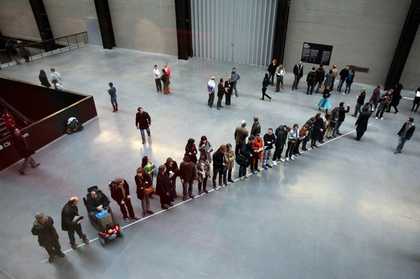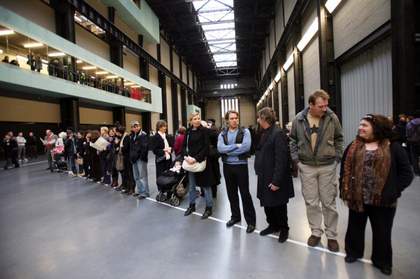Time 1970 (Tate T12208) is a performance by the Argentinian artist David Lamelas, performed at Tate Modern during UBS Openings: Live – The Living Currency on 26 and 27 January 2008. The Living Currency was a two-day exhibition, programmed as part of UBS Openings: Live, a series of bi-monthly performance events celebrating contemporary cultural practice at Tate Modern. Co-curated by Pierre Bal-Blanc in collaboration with Tate’s Alice Koegel and Vanessa Desclaux, The Living Currency took the 1970 text La Monnaie vivante by the French writer and painter Pierre Klossowski (1905–2001) as its starting point. In the text, Klossowski developed an alternative model of economic exchange, which places the body at the centre of the economy, understanding it as the only valid form of currency. At Tate The Living Currency sought to address this notion of the body as a form of value and a means of exchange in a number of ways, paying particular attention to historical and recent approaches to the body as a focus of performance in both the visual arts and contemporary dance. Along with this piece by David Lamelas, the exhibition featured works by Tania Bruguera, Prinz Gholam, Sanja Iveković, Isidoro Valcárcel Medina, Santiago Sierra, Annie Vigier and Franck Apertet (les gens D’Uterpan), Franz Erhard Walther and Lawrence Weiner.
Time was performed on Tate Modern’s Turbine Hall bridge. Lamelas gathered together a group of twenty-five volunteers and asked them to line up along a piece of tape, which he had laid diagonally across the floor. They were then instructed by Lamelas that, beginning with him at one end of the line, they must each in turn ‘hold’ time for one minute before ‘passing’ it to the person on their right. Stood side-by-side the participants transferred time down the line; one-by-one counting for sixty seconds – some using watches or their phones – before telling the time aloud to the person next to them as a signal for them to then begin counting. As the last person in the process counted down one minute, Lamelas ran from the beginning to the end of the line to conclude the performance, which lasted approximately twenty-five minutes. With this work Lamelas set out to capture the essence of time, making it observable through the actions and speech of the performers. By marking time through the bodies of the performers the work propositioned time as a social construct; something subjective as opposed to understanding it as objective, finite or measurable. The performance suggested, indeed, that time could be transformed and modified by the individuals who perceived it.
Originally conceived at a ski resort workshop in the French Alps in 1970, Time has been performed in a number of locations, including Frieze Art Fair, London in 2006 and Galerie Jan Mot, Brussels in 2005. Talking about the initial motivation behind the work, Lamelas has said that he had wanted to ‘get rid of the object’, to create an artwork that was not tied to any particular medium, but rather existed as an idea alone and hence could travel, be performed in any space and in any language.1
The performance is completely self-sufficient and self-reflexive, taking time as both its concept and its form. In 2006 Time was acquired for the Tate collection using funds provided by the 2005 Outset/Frieze Art Fair Fund, making it one of the first examples of a performance bought by the institution in the form of a set of instructions explaining how to restage it.2
Speaking of the acquisition Lamalas said: ‘It means I achieved what I wanted to do. That is to produce a work that exists as a concept rather than an object.’3
Clare Gormley
October 2015



